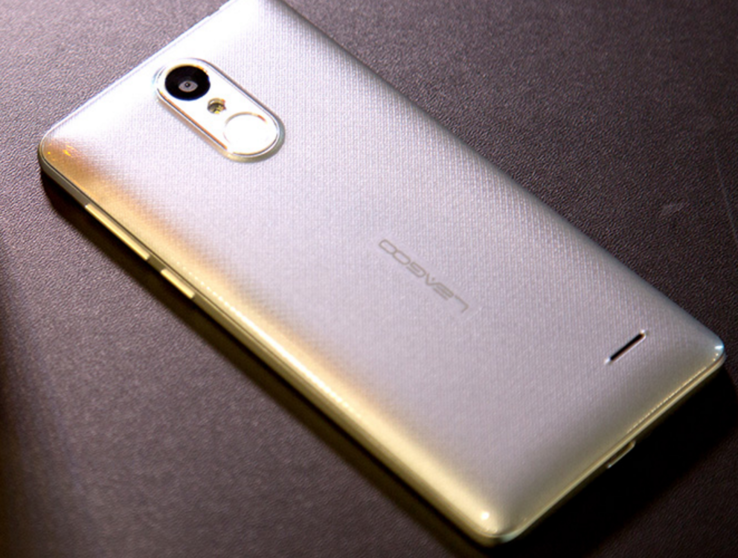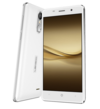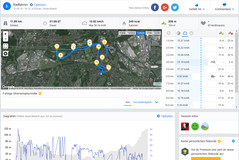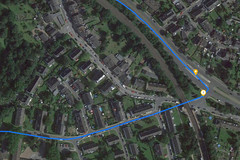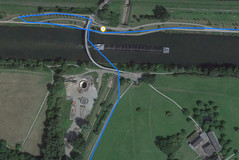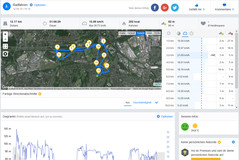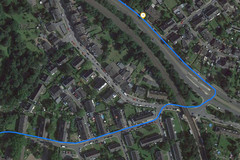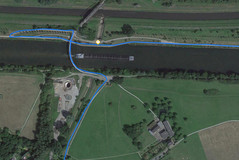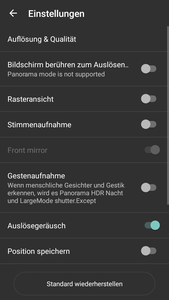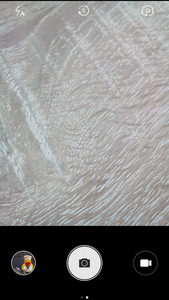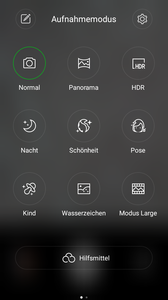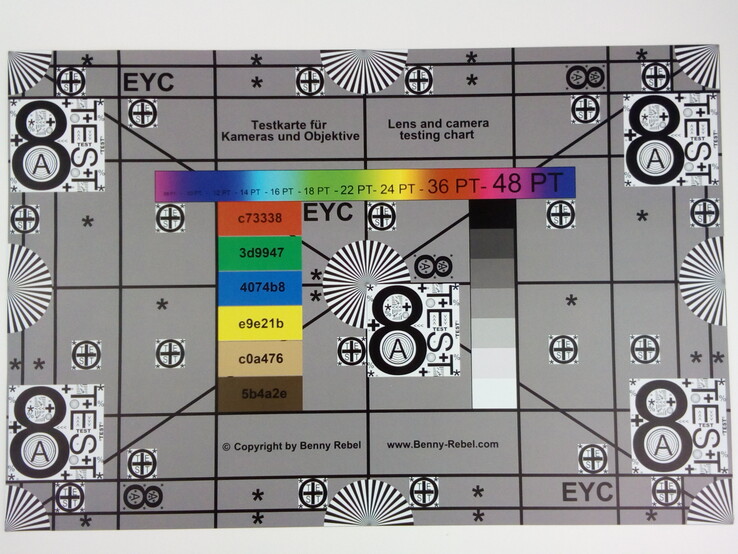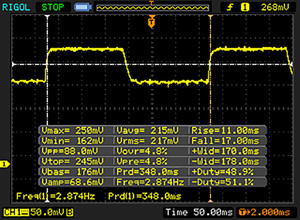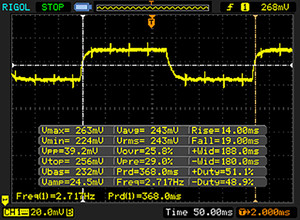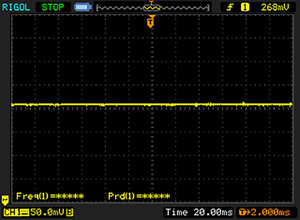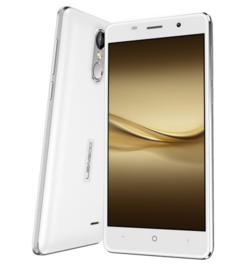Breve análisis del Smartphone Leagoo M5
Top 10 Análisis
» Top 10 Portátiles Multimedia
» Top 10 Portátiles de Juego
» Top 10 Portátiles de Juego ligeros
» Top 10 Portátiles Asequibles de Oficina/Empresa
» Top 10 Portátiles de Juego Ligeros
» Top 10 Portátiles de Oficina/Empresa Premium
» Top 10 Estaciones de Trabajo
» Top 10 Subportátiles
» Top 10 Ultrabooks
» Top 10 Convertibles
» Top 10 Tablets
» Top 10 Tablets Windows
» Top 10 Tablets de menos de 250 Euros
» Top 10 Phablets (>5.5")
» Top 10 Smartphones
» Top 10 Smartphones (≤5")
» Top 10 Smartphones de menos de 300 Euros
» Top 10 Smartphones de menos de 120 Euros
» Top 10 Portátiles de menos de 1000 Euros
» Top 10 Portátiles de menos de 500 Euros
» Top 10 Portátiles de menos de 300 Euros
» Los Mejores Displays de Portátiles Analizados por Notebookcheck
| Networking | |
| iperf Server (receive) TCP 1 m | |
| Xiaomi Mi 5 | |
| Ulefone Metal | |
| Archos 50 Platinum 4G | |
| Oukitel U7 Plus | |
| Leagoo M5 | |
| Archos 50e Neon | |
| iperf Client (transmit) TCP 1 m | |
| Xiaomi Mi 5 | |
| Ulefone Metal | |
| Oukitel U7 Plus | |
| Leagoo M5 | |
| Archos 50 Platinum 4G | |
| Archos 50e Neon | |
| |||||||||||||||||||||||||
iluminación: 92 %
Brillo con batería: 401 cd/m²
Contraste: 757:1 (Negro: 0.53 cd/m²)
ΔE Color 9.7 | 0.5-29.43 Ø5
ΔE Greyscale 13.3 | 0.57-98 Ø5.3
Gamma: 2.3
| Leagoo M5 IPS, 1280x720, 5.00 | Oukitel U7 Plus IPS, 1280x720, 5.50 | Oukitel K4000 Pro IPS, 1280x720, 5.00 | Ulefone Metal IPS, 1280x720, 5.00 | Wiko Jerry IPS, 854x480, 5.00 | Wiko Robby IPS, 1280x720, 5.50 | Archos 50 Platinum 4G IPS, 1280x720, 5.00 | Archos 50e Neon TFT, 854x480, 5.00 | Xiaomi Mi 5 IPS, 1920x1080, 5.15 | |
|---|---|---|---|---|---|---|---|---|---|
| Screen | 16% | 17% | 5% | 16% | 31% | 9% | 0% | 45% | |
| Brightness middle | 401 | 462 15% | 360 -10% | 312 -22% | 432 8% | 621 55% | 344 -14% | 443 10% | 598 49% |
| Brightness | 387 | 437 13% | 367 -5% | 315 -19% | 436 13% | 576 49% | 349 -10% | 430 11% | 566 46% |
| Brightness Distribution | 92 | 91 -1% | 89 -3% | 87 -5% | 91 -1% | 88 -4% | 89 -3% | 94 2% | 90 -2% |
| Black Level * | 0.53 | 0.58 -9% | 0.36 32% | 0.56 -6% | 0.57 -8% | 0.73 -38% | 0.65 -23% | 0.38 28% | 0.51 4% |
| Contrast | 757 | 797 5% | 1000 32% | 557 -26% | 758 0% | 851 12% | 529 -30% | 1166 54% | 1173 55% |
| Colorchecker dE 2000 * | 9.7 | 7.5 23% | 9.01 7% | 6.8 30% | 7 28% | 4.7 52% | 5.8 40% | 13.9 -43% | 3.5 64% |
| Colorchecker dE 2000 max. * | 22.3 | 12.8 43% | 12.58 44% | 14 37% | 12.4 44% | 9.4 58% | 10.7 52% | 29.5 -32% | 6.1 73% |
| Greyscale dE 2000 * | 13.3 | 8.5 36% | 8.67 35% | 7.1 47% | 7.6 43% | 5.2 61% | 5.7 57% | 17.3 -30% | 3.5 74% |
| Gamma | 2.3 96% | 2.54 87% | 2.66 83% | 2.77 79% | 2.1 105% | 2.51 88% | 2.1 105% | 2.93 75% | 2.29 96% |
| CCT | 10359 63% | 8914 73% | 7641 85% | 7402 88% | 8368 78% | 7505 87% | 7792 83% | 22878 28% | 6532 100% |
* ... más pequeño es mejor
Tiempos de respuesta del display
| ↔ Tiempo de respuesta de Negro a Blanco | ||
|---|---|---|
| 28 ms ... subida ↗ y bajada ↘ combinada | ↗ 11 ms subida | |
| ↘ 17 ms bajada | ||
| La pantalla mostró tiempos de respuesta relativamente lentos en nuestros tests pero podría ser demasiado lenta para los jugones. En comparación, todos los dispositivos de prueba van de ##min### (mínimo) a 240 (máximo) ms. » 67 % de todos los dispositivos son mejores. Eso quiere decir que el tiempo de respuesta es peor que la media (21.5 ms) de todos los dispositivos testados. | ||
| ↔ Tiempo de respuesta 50% Gris a 80% Gris | ||
| 33 ms ... subida ↗ y bajada ↘ combinada | ↗ 14 ms subida | |
| ↘ 19 ms bajada | ||
| La pantalla mostró tiempos de respuesta lentos en nuestros tests y podría ser demasiado lenta para los jugones. En comparación, todos los dispositivos de prueba van de ##min### (mínimo) a 636 (máximo) ms. » 38 % de todos los dispositivos son mejores. Eso quiere decir que el tiempo de respuesta es similar al dispositivo testado medio (33.8 ms). | ||
Parpadeo de Pantalla / PWM (Pulse-Width Modulation)
| Parpadeo de Pantalla / PWM no detectado | |||
Comparación: 53 % de todos los dispositivos testados no usaron PWM para atenuar el display. Si se usó, medimos una media de 17933 (mínimo: 5 - máxmo: 3846000) Hz. | |||
| AndroBench 3-5 | |
| Sequential Write 256KB SDCard (ordenar por valor) | |
| Leagoo M5 | |
| Oukitel U7 Plus | |
| Ulefone Metal | |
| Wiko Jerry | |
| Wiko Robby | |
| Archos 50 Platinum 4G | |
| Archos 50e Neon | |
| Sequential Read 256KB SDCard (ordenar por valor) | |
| Leagoo M5 | |
| Oukitel U7 Plus | |
| Ulefone Metal | |
| Wiko Jerry | |
| Wiko Robby | |
| Archos 50 Platinum 4G | |
| Archos 50e Neon | |
| Random Write 4KB (ordenar por valor) | |
| Leagoo M5 | |
| Oukitel U7 Plus | |
| Oukitel K4000 Pro | |
| Ulefone Metal | |
| Wiko Jerry | |
| Wiko Robby | |
| Archos 50 Platinum 4G | |
| Archos 50e Neon | |
| Xiaomi Mi 5 | |
| Random Read 4KB (ordenar por valor) | |
| Leagoo M5 | |
| Oukitel U7 Plus | |
| Oukitel K4000 Pro | |
| Ulefone Metal | |
| Wiko Jerry | |
| Wiko Robby | |
| Archos 50 Platinum 4G | |
| Archos 50e Neon | |
| Xiaomi Mi 5 | |
| Sequential Write 256KB (ordenar por valor) | |
| Leagoo M5 | |
| Oukitel U7 Plus | |
| Oukitel K4000 Pro | |
| Ulefone Metal | |
| Wiko Jerry | |
| Wiko Robby | |
| Archos 50 Platinum 4G | |
| Archos 50e Neon | |
| Xiaomi Mi 5 | |
| Sequential Read 256KB (ordenar por valor) | |
| Leagoo M5 | |
| Oukitel U7 Plus | |
| Oukitel K4000 Pro | |
| Ulefone Metal | |
| Wiko Jerry | |
| Wiko Robby | |
| Archos 50 Platinum 4G | |
| Archos 50e Neon | |
| Xiaomi Mi 5 | |
| AnTuTu v6 - Total Score (ordenar por valor) | |
| Leagoo M5 | |
| Oukitel U7 Plus | |
| Oukitel K4000 Pro | |
| Ulefone Metal | |
| Wiko Jerry | |
| Wiko Robby | |
| Archos 50 Platinum 4G | |
| Archos 50e Neon | |
| Xiaomi Mi 5 | |
| 3DMark | |
| 1280x720 offscreen Ice Storm Unlimited Score (ordenar por valor) | |
| Leagoo M5 | |
| Oukitel U7 Plus | |
| Oukitel K4000 Pro | |
| Ulefone Metal | |
| Wiko Jerry | |
| Wiko Robby | |
| Archos 50 Platinum 4G | |
| Archos 50e Neon | |
| Xiaomi Mi 5 | |
| 1280x720 offscreen Ice Storm Unlimited Graphics Score (ordenar por valor) | |
| Leagoo M5 | |
| Oukitel U7 Plus | |
| Oukitel K4000 Pro | |
| Ulefone Metal | |
| Wiko Jerry | |
| Wiko Robby | |
| Archos 50 Platinum 4G | |
| Archos 50e Neon | |
| Xiaomi Mi 5 | |
| 1280x720 offscreen Ice Storm Unlimited Physics (ordenar por valor) | |
| Leagoo M5 | |
| Oukitel U7 Plus | |
| Oukitel K4000 Pro | |
| Ulefone Metal | |
| Wiko Jerry | |
| Wiko Robby | |
| Archos 50 Platinum 4G | |
| Archos 50e Neon | |
| Xiaomi Mi 5 | |
| 2560x1440 Sling Shot OpenGL ES 3.0 (ordenar por valor) | |
| Oukitel U7 Plus | |
| Oukitel K4000 Pro | |
| Ulefone Metal | |
| Xiaomi Mi 5 | |
| 2560x1440 Sling Shot OpenGL ES 3.0 Graphics (ordenar por valor) | |
| Oukitel U7 Plus | |
| Oukitel K4000 Pro | |
| Ulefone Metal | |
| Xiaomi Mi 5 | |
| 2560x1440 Sling Shot OpenGL ES 3.0 Physics (ordenar por valor) | |
| Oukitel U7 Plus | |
| Oukitel K4000 Pro | |
| Ulefone Metal | |
| Xiaomi Mi 5 | |
| GFXBench (DX / GLBenchmark) 2.7 | |
| T-Rex Onscreen (ordenar por valor) | |
| Leagoo M5 | |
| Oukitel U7 Plus | |
| Oukitel K4000 Pro | |
| Ulefone Metal | |
| Wiko Jerry | |
| Wiko Robby | |
| Archos 50 Platinum 4G | |
| Archos 50e Neon | |
| Xiaomi Mi 5 | |
| 1920x1080 T-Rex Offscreen (ordenar por valor) | |
| Leagoo M5 | |
| Oukitel U7 Plus | |
| Ulefone Metal | |
| Wiko Jerry | |
| Wiko Robby | |
| Archos 50 Platinum 4G | |
| Archos 50e Neon | |
| Xiaomi Mi 5 | |
| PCMark for Android - Work performance score (ordenar por valor) | |
| Leagoo M5 | |
| Oukitel U7 Plus | |
| Oukitel K4000 Pro | |
| Ulefone Metal | |
| Wiko Jerry | |
| Wiko Robby | |
| Archos 50 Platinum 4G | |
| Archos 50e Neon | |
| Xiaomi Mi 5 | |
| BaseMark OS II | |
| Overall (ordenar por valor) | |
| Leagoo M5 | |
| Oukitel U7 Plus | |
| Oukitel K4000 Pro | |
| Ulefone Metal | |
| Wiko Jerry | |
| Wiko Robby | |
| Archos 50 Platinum 4G | |
| Archos 50e Neon | |
| Xiaomi Mi 5 | |
| System (ordenar por valor) | |
| Leagoo M5 | |
| Oukitel U7 Plus | |
| Oukitel K4000 Pro | |
| Ulefone Metal | |
| Wiko Jerry | |
| Wiko Robby | |
| Archos 50 Platinum 4G | |
| Archos 50e Neon | |
| Xiaomi Mi 5 | |
| Memory (ordenar por valor) | |
| Leagoo M5 | |
| Oukitel U7 Plus | |
| Oukitel K4000 Pro | |
| Ulefone Metal | |
| Wiko Jerry | |
| Wiko Robby | |
| Archos 50 Platinum 4G | |
| Archos 50e Neon | |
| Xiaomi Mi 5 | |
| Graphics (ordenar por valor) | |
| Leagoo M5 | |
| Oukitel U7 Plus | |
| Oukitel K4000 Pro | |
| Ulefone Metal | |
| Wiko Jerry | |
| Wiko Robby | |
| Archos 50 Platinum 4G | |
| Archos 50e Neon | |
| Xiaomi Mi 5 | |
| Web (ordenar por valor) | |
| Leagoo M5 | |
| Oukitel U7 Plus | |
| Oukitel K4000 Pro | |
| Ulefone Metal | |
| Wiko Jerry | |
| Wiko Robby | |
| Archos 50 Platinum 4G | |
| Archos 50e Neon | |
| Xiaomi Mi 5 | |
| Geekbench 4.0 | |
| 64 Bit Multi-Core Score (ordenar por valor) | |
| Leagoo M5 | |
| Oukitel U7 Plus | |
| Ulefone Metal | |
| Archos 50 Platinum 4G | |
| 64 Bit Single-Core Score (ordenar por valor) | |
| Leagoo M5 | |
| Oukitel U7 Plus | |
| Ulefone Metal | |
| Archos 50 Platinum 4G | |
| JetStream 1.1 - Total Score (ordenar por valor) | |
| Leagoo M5 | |
| Oukitel U7 Plus | |
| Oukitel K4000 Pro | |
| Ulefone Metal | |
| Wiko Jerry | |
| Wiko Robby | |
| Archos 50 Platinum 4G | |
| Archos 50e Neon | |
| Xiaomi Mi 5 | |
| Octane V2 - Total Score (ordenar por valor) | |
| Leagoo M5 | |
| Oukitel U7 Plus | |
| Oukitel K4000 Pro | |
| Ulefone Metal | |
| Wiko Jerry | |
| Wiko Robby | |
| Archos 50 Platinum 4G | |
| Archos 50e Neon | |
| Xiaomi Mi 5 | |
| Mozilla Kraken 1.1 - Total (ordenar por valor) | |
| Leagoo M5 | |
| Oukitel U7 Plus | |
| Oukitel K4000 Pro | |
| Ulefone Metal | |
| Wiko Jerry | |
| Wiko Robby | |
| Archos 50 Platinum 4G | |
| Archos 50e Neon | |
| Xiaomi Mi 5 | |
* ... más pequeño es mejor
(-) The maximum temperature on the upper side is 46.4 °C / 116 F, compared to the average of 35 °C / 95 F, ranging from 21.9 to 56 °C for the class Smartphone.
(-) The bottom heats up to a maximum of 48.1 °C / 119 F, compared to the average of 33.8 °C / 93 F
(-) In idle usage, the average temperature for the upper side is 38.4 °C / 101 F, compared to the device average of 32.7 °C / 91 F.
Leagoo M5 audio analysis
(+) | speakers can play relatively loud (84.9 dB)
Bass 100 - 315 Hz
(-) | nearly no bass - on average 41.1% lower than median
(+) | bass is linear (6.2% delta to prev. frequency)
Mids 400 - 2000 Hz
(±) | reduced mids - on average 7.3% lower than median
(±) | linearity of mids is average (9.1% delta to prev. frequency)
Highs 2 - 16 kHz
(±) | higher highs - on average 6.1% higher than median
(+) | highs are linear (3.2% delta to prev. frequency)
Overall 100 - 16.000 Hz
(-) | overall sound is not linear (30% difference to median)
Compared to same class
» 74% of all tested devices in this class were better, 4% similar, 21% worse
» The best had a delta of 12%, average was 38%, worst was 134%
Compared to all devices tested
» 86% of all tested devices were better, 3% similar, 11% worse
» The best had a delta of 4%, average was 25%, worst was 134%
Oukitel U7 Plus audio analysis
(±) | speaker loudness is average but good (81.6 dB)
Bass 100 - 315 Hz
(-) | nearly no bass - on average 31.6% lower than median
(±) | linearity of bass is average (7.4% delta to prev. frequency)
Mids 400 - 2000 Hz
(±) | reduced mids - on average 6.1% lower than median
(±) | linearity of mids is average (9.1% delta to prev. frequency)
Highs 2 - 16 kHz
(±) | higher highs - on average 9.3% higher than median
(±) | linearity of highs is average (9.2% delta to prev. frequency)
Overall 100 - 16.000 Hz
(-) | overall sound is not linear (34.2% difference to median)
Compared to same class
» 81% of all tested devices in this class were better, 2% similar, 17% worse
» The best had a delta of 12%, average was 38%, worst was 134%
Compared to all devices tested
» 91% of all tested devices were better, 1% similar, 7% worse
» The best had a delta of 4%, average was 25%, worst was 134%
Ulefone Metal audio analysis
(±) | speaker loudness is average but good (76.4 dB)
Bass 100 - 315 Hz
(-) | nearly no bass - on average 25.6% lower than median
(-) | bass is not linear (15.5% delta to prev. frequency)
Mids 400 - 2000 Hz
(+) | balanced mids - only 3.7% away from median
(±) | linearity of mids is average (8.2% delta to prev. frequency)
Highs 2 - 16 kHz
(±) | higher highs - on average 5.6% higher than median
(+) | highs are linear (6.5% delta to prev. frequency)
Overall 100 - 16.000 Hz
(±) | linearity of overall sound is average (24.4% difference to median)
Compared to same class
» 52% of all tested devices in this class were better, 7% similar, 40% worse
» The best had a delta of 12%, average was 38%, worst was 134%
Compared to all devices tested
» 70% of all tested devices were better, 6% similar, 24% worse
» The best had a delta of 4%, average was 25%, worst was 134%
Archos 50 Platinum 4G audio analysis
(±) | speaker loudness is average but good (81.2 dB)
Bass 100 - 315 Hz
(-) | nearly no bass - on average 39% lower than median
(±) | linearity of bass is average (8.5% delta to prev. frequency)
Mids 400 - 2000 Hz
(±) | reduced mids - on average 8.1% lower than median
(±) | linearity of mids is average (9.6% delta to prev. frequency)
Highs 2 - 16 kHz
(+) | balanced highs - only 2.3% away from median
(+) | highs are linear (3.4% delta to prev. frequency)
Overall 100 - 16.000 Hz
(-) | overall sound is not linear (30.6% difference to median)
Compared to same class
» 76% of all tested devices in this class were better, 4% similar, 20% worse
» The best had a delta of 12%, average was 38%, worst was 134%
Compared to all devices tested
» 87% of all tested devices were better, 3% similar, 10% worse
» The best had a delta of 4%, average was 25%, worst was 134%
| Off / Standby | |
| Ocioso | |
| Carga |
|
| Leagoo M5 2300 mAh | Oukitel U7 Plus 2500 mAh | Oukitel K4000 Pro 4600 mAh | Ulefone Metal 3050 mAh | Wiko Jerry 2000 mAh | Wiko Robby 2500 mAh | Archos 50 Platinum 4G 2200 mAh | Archos 50e Neon 2200 mAh | |
|---|---|---|---|---|---|---|---|---|
| Power Consumption | -2% | -65% | -15% | 14% | 7% | 31% | 27% | |
| Idle Minimum * | 0.81 | 0.86 -6% | 2.74 -238% | 1.41 -74% | 0.8 1% | 0.92 -14% | 0.59 27% | 0.56 31% |
| Idle Average * | 2.26 | 2.68 -19% | 3.92 -73% | 2.46 -9% | 2.02 11% | 2.12 6% | 1.68 26% | 1.58 30% |
| Idle Maximum * | 2.39 | 2.78 -16% | 4.05 -69% | 2.83 -18% | 2.19 8% | 2.34 2% | 1.79 25% | 1.8 25% |
| Load Average * | 6.97 | 5.33 24% | 4.84 31% | 5.15 26% | 5.02 28% | 5.3 24% | 4.22 39% | 5.22 25% |
| Load Maximum * | 7.03 | 6.49 8% | 5.42 23% | 7.05 -0% | 5.52 21% | 5.78 18% | 4.26 39% | 5.34 24% |
* ... más pequeño es mejor
| Leagoo M5 2300 mAh | Oukitel U7 Plus 2500 mAh | Oukitel K4000 Pro 4600 mAh | Ulefone Metal 3050 mAh | Wiko Jerry 2000 mAh | Wiko Robby 2500 mAh | Archos 50 Platinum 4G 2200 mAh | Archos 50e Neon 2200 mAh | |
|---|---|---|---|---|---|---|---|---|
| Duración de Batería | ||||||||
| WiFi v1.3 | 406 | 366 -10% | 711 75% | 403 -1% | 475 17% | 712 75% | 384 -5% | 498 23% |
Pro
Contra
Aunque nuestros contras superan los pros del Leagoo M5, el dispositivo básico de 65 Euros no es inevitablemente un mal smartphone. La configuración técnica y su resistencia a influencias externas (aún cuando no pudimos testar este hecho) son un fuerte argumento de compra para este nivel de precios. Sin embargo, otros smartphones ofrecen un paquete total mejor aunque tengan un precio de compra más alto. Ante todo, nombraríamos al UleFone Meta o UHANS S1. Los compradores que no quieren tratar con importadores pueden encontrar la alternativa adecuada en el Coolpad Porto S o ZTE's Blade A452.
Demasiadas cosas que criticar nos impiden darle al Leagoo M5 una recomendación de compra a pesar de las buenas especificaciones técnicas y el bajísimo precio de compra.
Ésta es una versión acortada del análisis original. Puedes leer el análisis completo en inglés aquí.
Leagoo M5
-
10/06/2016 v5.1(old)
Marcus Herbrich


 Deutsch
Deutsch English
English Español
Español Français
Français Italiano
Italiano Nederlands
Nederlands Polski
Polski Português
Português Русский
Русский Türkçe
Türkçe Svenska
Svenska Chinese
Chinese Magyar
Magyar